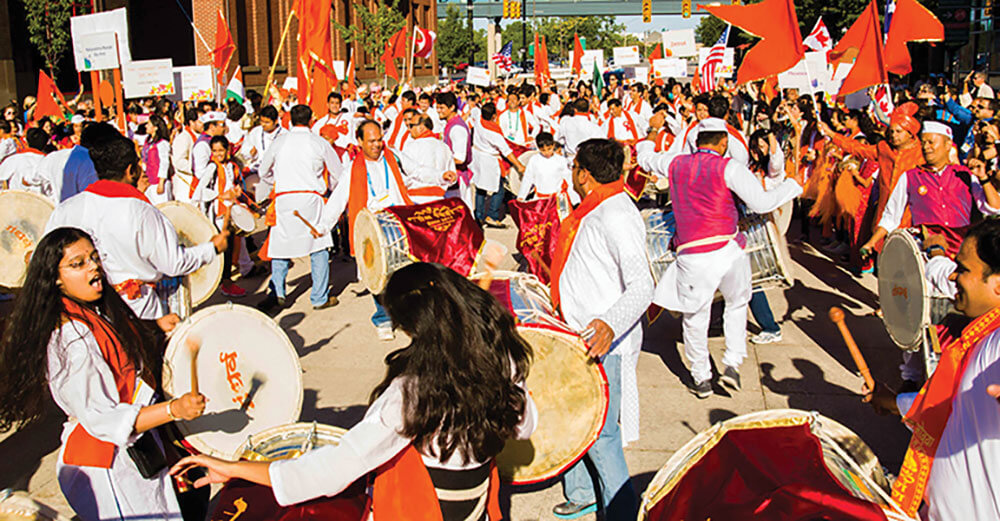
It took a ton of rice to feed BMM 2017 attendees.
Like many culinary professionals, master chef Josef Huber — who oversees culinary operations for five hotels in Grand Rapids, Michigan — has learned to adjust to evolving food preferences and restrictions, from vegetarianism and gluten intolerance to shellfish allergies or aversion to pork.
The challenge that awaited Huber and his team last summer, though, was more formidable: Learn a raft of new dishes from a specific region in India, and then serve them to 4,000 attendees of the 2017 convention of the Bruhan Maharashtra Mandal (BMM) of North America, July 6–9. “It was all hands on deck,” said Huber, corporate executive chef of AHC+Hospitality, formerly known as Amway Hotel Corporation.
BMM 2017, held at the DeVos Place Convention Center, was one of the largest meetings Grand Rapids had ever hosted — a biennial convention of people with roots in the western Indian state of Maharashtra (which includes Mumbai) for business and social networking, as well as cultural events. A cornerstone of the convention is sharing meals of Maharashtrian food, a vegetable-heavy cuisine with dishes such as bhaji, or savory fritters; a chickpea-flour curry called jhunka; and hakka noodles, a dish influenced by China, which borders Maharashtra.
“[Marathi] eat a different cuisine completely, so we had to prepare authentic Indian meals for them,” said Kelly Van Dyke, CMP, CTA, assistant director of conventions for the Amway Grand Plaza Hotel, which is connected to and provides catering to DeVos Place. Van Dyke worked with teams at the center and BMM to coordinate on-site food and beverage. “This was not so much a dietary restriction or religious restriction, rather a group preference for authentic food that met their needs. We had not served this food before.”
With so much unfamiliar ground to cover, the planning started early — about 18 months before the actual event. AH+C manages three downtown Grand Rapids Hotels — including the 682-room Amway Grand Plaza Hotel — but its culinary team was also in charge of executing four days of meals at the center.
A Ton of Basmati Rice
Huber and his team began meeting with Van Dyke 18 months before BMM 2017 to plan menus, guided by Rajbhog Foods, a New Jersey–based Indian caterer that had coordinated with BMM on meal planning for previous biennial conventions. “We worked in tandem with [the caterer] to execute the dishes and perfect the taste, appearance, and texture required for such a large group,” Huber told Convene via email. Texts, voicemail, face-to-face meetings “with all of the departments of the hotel” were constant, Huber said, especially within Huber’s culinary team of two dozen chefs and roughly 155 cooks.
Huber also had to figure out sourcing for large amounts of not-quite-so-common ingredients, such as chickpea flour (also called gram flour), plus finesse the details of production. How many cooks would be necessary on the line during the event? How would the team keep consistent temperature control for each of the massive buffet-style meals during the four days of the event?
About Authenticity
Cooking an entirely unfamiliar cuisine for 4,000 attendees calls for flexibility. For Huber, it also required coordinating hundreds of staff at three hotels and the convention center — plus sourcing huge amounts of herbs, vegetables, and rice. What helped him cope? “Patience,” said Huber. “Be open to new ideas, cooperate across the board, and put egos aside. Great people can come together to meet any challenge.”
Van Dyke was in touch with the committee from Bruhan Maharashtra Mandal monthly until about six months before the start date, when the meetings became more frequent. The size of the group, Van Dyke said, required assiduous planning — everything from how much equipment was needed in terms of the number of hot boxes, ladles, disposables, plates, and chafing dishes to how many staff would be necessary.
One week prior to the arrival of attendees, four chefs from Rajbhog Foods flew to Grand Rapids to assist with on-site execution. Huber’s staff fielded three semi-truck-sized loads of ingredients, including 11 large cases of fresh coriander, hundreds of pounds of eggplant and a ton — literally — of basmati rice.
Mass-Production Rotations
BMM attendees who arrived by July 6 enjoyed a breakfast that included motichoor ladoo, or Indian sweets made with gram flour and spiced with cardamom, and a lunch of samosas, tadka dal, and butter chicken. During the rest of the conference — from a July 6 banquet dinner to a closing lunch on July 9 — kati rolls and various kinds of bhaji made appearances, as did the crispy, spiced Maharashtrian snack called kothimbir vadi and veg kohlapuri, a spicy vegetable curry.
Labels for all of the buffet items were in Marathi and English, and keeping each meal rolling required 24 lines of cooks plating between seven to 13 hot and cold items for each lunch and dinner service, over four days. “It was mass-production rotations,” Huber said, in both the back of the house and the front of the house. “We were rotating and cooking in large batches.”
A high point of BMM 2017, for both attendees and spectators in Grand Rapids, was an exuberant traditional parade called the Granth Dindi, a procession of Maharasthrian drumming, dancing, colorful flag waving, and performances through downtown on the morning of July 8.
The confluence of cultures that BMM 2017 brought to Grand Rapids was also an education for Huber and Van Dyke, who ate Indian food for four days straight. “It was important to them for us to experience their culture and experience the food,” Van Dyke said. “They were very welcoming, and it was a really great experience.”
F&B is supported by the Louisville Convention & Visitors Bureau, gotolouisville.com.

